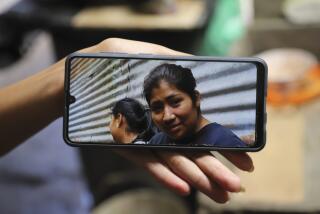COLUMN ONE : Serial Killer Is Stalking the Oasis : Seven girls have been slain in tiny Belize in the past year. The crimes underscore growing dysfunction in the former British colony.
- Share via
BELIZE CITY, Belize — Someone is killing Belize’s little girls.
In the past year, the bodies of seven girls, ages 9 to 15, have been found mutilated along deserted highways or in shallow tideland, many of them with signs of rape. The slayings have continued even when police have had suspects in custody.
The first serial killings in Belizeans’ memory have shocked Central America’s least populous nation, whose 230,000 people, living mainly in hamlets or on farms, had thought of Belize as a tropical Mayberry, an oasis of peace at the edge of Central American violence.
The inability of the police to solve the killings seems to underscore the rising level of dysfunction in this former British colony. Once homogeneous and English-speaking, Belize now must cope with thousands of Spanish-speaking refugees who fled civil wars and unrest in El Salvador, Guatemala and Honduras. Once relatively prosperous, it now finds its main exports--citrus fruit and bananas--are no longer internationally competitive, and incomes are falling. In a land where people knew each other from childhood, neighbors today are more likely to be strangers who can’t even communicate.
Into this mix has stepped a killer, or killers. The effect on Belize has been devastating, as though seven girls had been slain in one year in a city a little bigger than Glendale--and the killer was still at large.
“If someone had told me five years ago that this could happen in our community, I would not have believed them,” said Jennifer August, vice chairwoman of the Belize Organization for Women and Development, a private group that fights violence against women.
While domestic violence has been a persistent problem here, both for women and children, youngsters used to be safe from child molesters and killers.
Robbery was an oddity, and the rare slaying was usually the result of a drunken brawl. Nobody actually set out to kill anyone, least of all little girls. Even if someone had preyed on Belize’s young ones, it was more likely that such a person would have been caught.
Until recently, August said, people believed and practiced the saying “It takes a village to raise a child.” Any adult who saw a child loitering in the street felt free to send the youngster home or ask her why she was talking to a stranger.
August was raised by a single mother, like many of the victims. But she had a strict schedule of school, church, homework and chores, she said. Even if her mother wasn’t always home, neighbors rocking on their front porches with a view of the whole block quickly told her parent if any of the children broke that routine.
Now the neighbors are inside watching violence and commercials on the 60 cable television channels from all over the world available today in Belize City.
At the same time, an estimated 100,000 Belizean citizens are working in cities such as Miami and Los Angeles, sending money home to children who are being raised by aging grandparents, who may not be equipped to shield them from harm. So people are demanding that the police protect these most vulnerable members of society.
Citizens groups organized a candlelight vigil in July to demand more aggressive police work to solve the killings. Since school started again this month, many parents have been walking children to their classes.
“It affects all of us as a community because our children are not safe,” August said. “Next time, it could be your daughter or it could be my daughter.”
A Pattern of Victims Emerges
But the pattern of the killings shows that the victims are most likely to be poor youngsters from single-parent homes, such as 13-year-old Sherilee Nichols, the first girl to disappear.
Sherilee had just started fifth grade at Wesly Upper School on the south side of Belize City, in a neighborhood of small wooden and concrete-block houses with fading paint, the poorest part of this city of 50,000 people.
Sherilee’s mother, June Gabourel, supported her four children on the $63 a week she earns sweeping the city streets.
Sherilee’s fourth-grade teacher, Erminda Reid, recalls her as a happy child who liked reading and math. “She liked to talk and share her opinions,” she said.
Reid and August, also a teacher at the school, bought material for Sherilee’s school uniforms, and Reid’s sister sewed them.
“She told me, ‘Teacher, my mommy go to work early and she doesn’t have time to comb my hair,’ ” Reid said. So Sherilee came to school a few minutes before classes started, and Reid brushed her hair.
But although the child arrived early in the morning, she was consistently late coming back from lunch. When she came in late, she was usually carrying a piece of fruit like that sold from carts around the school, Reid said. The teacher worried how a child whose mother couldn’t afford school uniforms got the money to buy such fruit.
Reid’s efforts with Sherilee reflect a neighborly caring that once was common in Belize but is becoming rare, people here said. “People used to scold other people’s children, but you can’t do that anymore,” August said.
Meanwhile, people without access to money from abroad are becoming desperately poor--and some youngsters are being tempted to accept sexual abuse in return for treats and money.
“Many young children are getting sexually active for money,” said Zaida Young, research information officer at the National Organization for Protection From Child Abuse, a private group. “No one has talked about it until now [that] children from poor, single-parent families are being lured to their death.”
A year ago this month, Sherilee disappeared. On Oct. 9, 1998, her body was found along Belize’s Western Highway, submerged in a pool of water with more than 40 stab wounds in her chest and head. The body showed signs of rape.
Ominously, she was wearing clothes that belonged to Jay Blades, a 9-year-old girl who had disappeared two days before Sherilee’s body was found. Jay’s remains were located six months later. By that time, only a skull and bones were left.
Body Discovered a Few Yards Out to Sea
During the time that Jay was missing, three more girls disappeared. Samantha Gordon, 15, was found floating naked, with her back and knees covered with cuts, a few yards out to sea Nov. 8.
Jackie Malic, 12, didn’t return from morning recess on her school playground; her body, with the left hand cut off, was found March 24 in the same area where Sherilee’s remains had been located five months before. Just as Sherilee had brought fruit to school, Jackie had brought clothes and money home to her grandmother’s house, and no one knew--or asked--where she got them.
About the same time, the first killing outside Belize City, in the north, occurred. Becky Gilharry, 13, was found dead on the grounds of the Santa Rita Mayan ruin in Corozal.
Under growing public pressure, officials put guards on school playgrounds and imposed an 8 p.m.-to-6 a.m. curfew for anyone 16 or younger. Finally, police made an arrest.
Michael Williams, a 40-year-old auto mechanic from Belize City who had unsuccessfully offered Jackie and her sister a ride to school on the day she disappeared, had previously been questioned and released. After talking to more witnesses, including a 23-year-old woman who alleged that Williams had molested her when she was a child, police arrested him.
While he was in custody, 9-year-old Erica Wills disappeared. Three weeks later, on June 26, a skull and bones, picked clean by vultures, were found behind a quarry. Only a Tweety Bird ring and a hair band were left for Erica’s mother to recognize.
In the northern province of Orange Walk, the mother of 10-year-old Karen Cruz found out one Monday in June that the child’s aunt, who lived a block away, had sent Karen home Sunday afternoon. The girl never arrived. Her body, with signs of rape, was found at a stadium two blocks from her home.
Police arrested her uncle, Antonio Baeza. A few weeks later, on July 4, they also arrested five men from Belize City on suspicion of conspiring to murder Samantha eight months before.
Adolf Lucas, the country’s top prosecutor, watched the television announcements of the arrests apprehensively. Police had not consulted him or shown him their evidence before they detained any of the men, he said.
“The police are being pressured, so they must find someone,” Lucas said.
When the case files arrived on his desk, Lucas’ forebodings were confirmed. The police had no physical evidence linking the suspects to the crimes, he said. The arrests were based on the testimony of witnesses who claimed to have seen the men at night from several blocks away or while driving down the highway.
One witness said he had seen Williams near the place where Jackie’s body was found at a time when the suspect was in police custody. The 23-year-old woman’s statement about an alleged rape a decade ago was simply prejudicial, Lucas said.
Further, Williams had alibis from customers whose cars he was repairing the day Jackie disappeared, including a police officer who had seen him at the shop that morning, Lucas said.
“There’s no case,” he said of Williams. In the case of the five men arrested July 4, Lucas noted, “Maybe it was them, but we can’t work with maybe.”
On Aug. 19, he released all the Belize City suspects for lack of evidence. Baeza is still being held.
Three high-ranking police officials made and failed to keep appointments to discuss the cases.
The unsolved killings are an embarrassment for the small but professional national police force that has taken pride in its cooperation with international law enforcement to wipe out marijuana production early in this decade and, more recently, curb cocaine and heroin transit along this country’s coast and through its jungles.
“Belize is so small, there are only two highways from the city,” said Young, the anti-child abuse information officer, expressing the public’s exasperation with the inability of the police to solve the killings. “The police do need some international help in going about these cases. They did all that they could do, but they are limited and they need expert help.”
Police Commissioner Ornell Brooks said on local television that he is seeking help from the FBI and Scotland Yard, but neither U.S. nor British officials would comment on whether they are providing assistance.
Although no more killings have been reported since Karen’s death, there are indications that the attacks are continuing. Early this month, a Belize City man reported to police that he was buying groceries with his 10-year-old daughter one evening and sent her home before him with items that her mother needed to make dinner.
A man in a stocking mask jumped out of a red car and grabbed her, the girl said. She escaped by kicking and biting him.
People such as Young and August, who work with children, believe that most of the young victims have been tempted with money and treats to accompany someone who has carefully planned the crime.
“Now that school is open, I worry that there is a stalker out there waiting to pounce on a child,” August said. “We need to do something to change what is happening in our society.”
More to Read
Sign up for Essential California
The most important California stories and recommendations in your inbox every morning.
You may occasionally receive promotional content from the Los Angeles Times.













